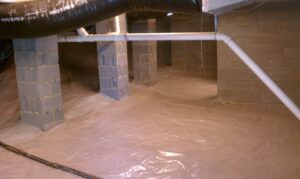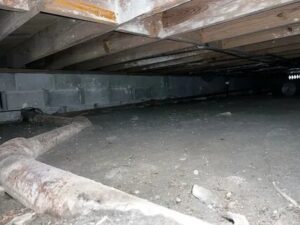Mold remediation in crawl spaces is not inherently permanent. Even after thorough professional treatment, mold can return if the root causes like excess moisture, poor drainage, or insufficient ventilation are not corrected. Remediation removes existing mold colonies but does not immunize the area against future infestations unless preventative steps are consistently maintained.
In this guide, you will learn why crawl space mold can return, what influences permanence, the methods available, and key considerations before making any decisions. Gain a full understanding so you can make an informed choice to protect your home and health.
Understanding Crawl Space Mold Remediation
Crawl space mold remediation targets the visible and hidden colonies of mold, aiming to restore indoor air quality and preserve the structural integrity of your home. However, if moisture levels remain high or materials stay damp, mold spores can reestablish within 24 to 48 hours.
Why Mold Often Comes Back
- Persistent high humidity
- Untreated water leaks
- Absence of a vapor barrier
- Insufficient ventilation airflow
- Organic material exposure (wood, insulation, debris)
Bonus Tip: Regular humidity monitoring alarms can alert you before mold has a chance to regrow.

Key Factors Influencing Remediation Permanence
Several important factors determine whether mold remediation will last or if problems will resurface.
| Factor | Impact on Remediation Permanence |
| Moisture Control | Essential – mold cannot survive without moisture |
| Initial Remediation Quality | Comprehensive work limits future contamination |
| Building Material Type | Porous materials trap spores, increasing risk |
| Post-Remediation Maintenance | Regular inspections prevent early warning signs |
| Environmental Sealing | Vapor barriers and insulation inhibit moisture |
Quick Fact: The Environmental Protection Agency (EPA) states that 50% of household air comes from the crawl space, emphasizing the importance of treating it properly.
Crawl Space Mold Remediation Methods
Each remediation method offers different advantages in terms of effectiveness, cost, and long-term success.
| Method | Description | Effectiveness | Cost Estimate |
| Chemical Cleaning | Sprays and antimicrobial treatments | Moderate | $500 – $1,500 |
| Abrasive Removal | Sanding or soda blasting surfaces | High | $1,500 – $3,000 |
| Dry Ice Blasting | Freezing mold spores off materials | Very High | $2,500 – $4,000 |
| Crawl Space Encapsulation | Sealing surfaces with vapor barriers | Extremely High | $3,000 – $8,000 |
Bonus Tip: Dry ice blasting offers superior removal without introducing water, reducing secondary contamination risks.
Technical Specifications and Data
Understanding the environmental thresholds that encourage or deter mold growth is key to long-term prevention.
| Parameter | Safe Range | Mold Risk Range |
| Relative Humidity | 30% – 50% | Above 60% |
| Wood Moisture Content | 8% – 12% | Above 20% |
| Crawl Space Air Temperature | 50°F – 70°F | Above 70°F if humid |
| Vapor Barrier Thickness | Minimum 10-mil | Less than 6-mil risks punctures |
Market Fact: According to industry data, 90% of homes with chronic mold issues had inadequate vapor barriers or none at all in their crawl spaces.

Things to Consider Before Making a Decision
Before moving forward with remediation, evaluate these critical points to ensure you choose a solution that lasts.
Identify Moisture Sources First
- Inspect for plumbing leaks
- Examine exterior drainage and grading
- Check for groundwater seepage
- Test for high humidity levels during different seasons
Tip: A moisture meter provides precise readings of wood or concrete moisture content before work begins.
Evaluate Crawl Space Materials
- Fiberglass insulation retains moisture easily
- Exposed wood framing is a prime host for mold
- Dirt floors allow direct moisture transfer unless sealed
Replacing water-damaged materials often improves long-term outcomes.
Understand Preventative Measures
Lasting mold prevention involves:
- Installing dehumidifiers
- Adding high-quality vapor barriers
- Sealing vents appropriately depending on your climate
- Sloping landscaping to direct water away from the foundation
Choose a Remediation Expert with Moisture Control Focus
- Confirm comprehensive inspection services
- Ensure the company offers encapsulation, not just mold removal
- Look for warranties based on moisture management, not just cleaning
Bonus Tip: Ask for moisture readings before and after the job to verify effectiveness.
Common Questions About Crawl Space Mold Remediation
Can mold come back even after professional remediation?
Yes, without correcting moisture problems, mold can regrow even after a professional job.
Is crawl space encapsulation necessary after remediation?
While not mandatory, encapsulation offers the most reliable way to prevent moisture re-entry and future mold problems.
How fast can mold return if the underlying issues are not fixed?
Mold can begin growing within 24 to 48 hours if favorable conditions exist, such as high humidity and organic material exposure.
What are signs that mold has returned?
- Musty odors
- Discoloration on wood or insulation
- Increased allergy symptoms indoors
- Visible spotting or surface fuzz
How often should I inspect my crawl space after remediation?
Check at least twice a year, preferably during spring and fall, or immediately after major storms.
Make the Right Decision
Crawl space mold remediation is not a permanent fix unless it is paired with thorough moisture management and long-term maintenance practices. Addressing the root causes such as high humidity, poor drainage, and material vulnerabilities is essential to ensure lasting results.
Evaluate your home’s specific needs carefully. If you are committed to managing moisture levels permanently and investing in preventive measures like encapsulation and dehumidification, you can enjoy a mold-free crawl space for many years. Focus on proactive maintenance, smart material choices, and regular inspections to protect your home and health.
Crawl Space Mold Remediation FAQ
Is crawl space mold dangerous?
Yes, exposure to mold spores can cause respiratory issues, allergies, asthma flare-ups, and can lead to wood rot, damaging your home’s structure.
How do professionals remove mold from crawl spaces?
They remove mold by applying chemical cleaners, blasting techniques (abrasive or dry ice), and sometimes removing affected materials before sealing the space against future moisture.
What is crawl space encapsulation?
Encapsulation is sealing the entire crawl space with heavy-duty vapor barriers across floors, walls, and sometimes ceilings, isolating the space from external moisture.
How much does crawl space mold remediation cost?
Average costs range from $500 to $4,000, depending on the severity of mold, the size of the area, and the method used. Encapsulation can add more to the total.
Can I DIY mold removal in a crawl space?
DIY mold removal is risky. Homeowners often remove only visible mold without solving moisture issues, leading to recurring infestations and potential structural damage.